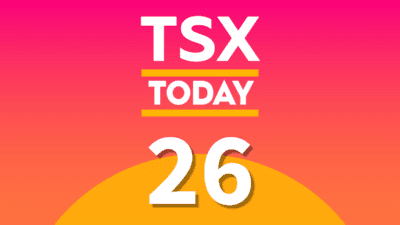Take Stock is the Motley Fool Canada’s free investing newsletter. To have future editions delivered directly to you, simply click here now.
Dear Fellow Fools,
It’s getting awfully hard to open a newspaper these days without reading something about the Canadian housing market. Just yesterday, an article appeared in The Wall Street Journal that conveyed some work done by a group of economists at Deutsche Bank that labelled our housing market as the most overvalued in the entire world. Imagine that – little old us!
We’re not going to weigh in on the bubble/no bubble debate here this week. Instead, this week’s Take Stock is going to provide some insight into why we’re even having this debate. One of the reasons is fairly transparent. The other, less so. Combined, they’ve resulted in a run that, at least for several major Canadian metropolitan areas, has been rather breathtaking.
Reason #1: The Cost of Credit
We’ll start with the transparent reason. The cost of credit refers to interest rates and the impact they’ve had. We covered this topic in more detail about a month ago here in Take Stock.
Because the cost to borrow money has been low, home buyers have essentially been able to buy more house than they otherwise would have. Debt is relatively affordable under our current monetary regime and we Canadians are taking advantage of it. In fact, at 163.4%, our household debt-to-income ratio stands at an all-time high. Mortgages are a big reason why.
As a stand-alone, the cost of credit is a decent enough reason to explain why Canada’s housing market stands where it does in the Deutsche Bank study. However, rates are low all over the world. Our housing market is not the only one benefitting from this dynamic. There must be something else going on…..
Reason #2: The Availability of Credit
The world of lending (i.e., mortgages), in its simplest form, is populated by those who need money (borrowers) and those who have access to it (lenders). Borrowers go to lenders for loans. Loans are granted based on the borrower’s perceived ability to service that loan. In theory, would-be borrowers deemed unfit to service a loan are declined.
In a system where lenders control the availability of credit, the risk is left in the hands of the lender. If they lend to unfit borrowers, they won’t be long for this world.
The thing is, the availability of credit as it pertains to Canada’s housing market has not been left solely in the hands of the lenders. Meet the Canadian Mortgage and Housing Corporate – or the CMHC. This government entity has played a huge role in the run-up in Canadian house prices.
The Basics
In the world described above, where only lenders and borrowers exist, a borrower seeking a mortgage for the purchase of a home is typically required to make a down payment. Historically, this down payment had to amount to 25% of the value of the home (way back it was actually much more). Now it’s 20%.
The down payment is meant to protect the lender in the event of a borrower default. It provides a cushion that helps minimize the risk of a loss if the lender has to liquidate the property.
The CMHC, however, alters this relationship by providing mortgage insurance. Though the lenders have maintained a 20% down payment threshold, thanks to the CMHC, the size of the required down payment has come down dramatically. In fact, it fell to just 5% in the early 1990s and in 2006 the Crown corporation actually introduced a no-down-payment insurance option.
But, you ask, what about that nice cushion that is required by the lenders? Well, for any borrower that doesn’t have 20% to put down against a home, for the price of an insurance premium paid to the CMHC, they are able to make a down payment of essentially any amount they’d like. In exchange for this premium, the CMHC guarantees the loan – meaning, should it go into default, the bank will be repaid in full by the CMHC. The bank’s cushion remains.
There’s more
It’s clear that demand for housing will go up if:
- You go from a system that prevents potential home buyers that don’t have a 20% down payment from getting a mortgage
- To a system that essentially allows all would-be home buyers, in exchange for a relatively small fee (that can be tacked onto the mortgage), to get in the game
Because of the CMHC’s involvement, the availability of credit has expanded, which is not necessarily a bad thing. After all, housing activity has a huge multiplier effect through the economy — and heck, if it weren’t for the CMHC, I certainly wouldn’t have been able to pony up for my first house. There are many more of “me” out there.
Though the principles may sound reasonable, the program has appeared to lose some degree of focus in recent years. For instance, increasing the maximum insured mortgage from $250,000 to $1,000,000, and extending allowable amortization periods three times between 2005 and 2006 (we’re now back to where we started) only helped provide a catalyst to a market that was already heating up due to the declining cost of credit.
In addition, the government has greatly expanded the amount of insurance the CMHC is allowed to have underwritten at any given time. Currently, this limit sits at $600 billion, with $560 billion actually in force. In 2005, this figure sat at $273.7 billion, with a $300 billion limit in place.
The net result of this loss of focus and rapid expansion of the program in recent years: 75% of all Canadian mortgages are now insured by our federal government, up from just 30% in 1988 and 55% in 2003.
Where there’s smoke …
“Cost of credit” + “availability of credit” have led to articles like the one that came through today. And don’t get me wrong, I don’t want the run to end. However, here are a couple of indications that the federal government is scared. Really scared.
1. Through the expansion and policy changes that occurred, the CMHC was unregulated. There was essentially no oversight. This changed in April 2012. The operation must now answer to OSFI, the body that regulates Canada’s private financial institutions (i.e., banks and insurance companies). The implication here is that CMHC potentially hasn’t been run like a proper insurance operation, and this needs to change.
2. It sounds crazy that an operation with such influence wouldn’t be properly run. However, check out what the 2012 board at the CMHC looked like….
|
Background |
|
| Karen Kinsley, CEO |
Former VP/Treasurer of two real estate development companies |
| Michael Gendron, CFO |
Part-owner of VC firm that has a majority interest in a number of home-building and support companies in Edmonton |
| Michael Horgan |
– |
| Brian Johnston |
COO of Mattamy Homes |
| Sophie Joncas |
Formerly employed by construction and real estate firms |
| E. Anne MacDonald |
Real estate lawyer |
| James Millar |
– |
| Rennie Pieterman |
Partner at residential plumbing firm |
| Andre Plourde |
President of industrial real estate firm in Montreal |
| Ian Shugart |
– |
Source: CMHC 2012 Annual Report
Guess which industry doesn’t have a very good representation on the board? Insurance! Beyond the heavy bias toward those who would love to see the housing market keep booming, the other item of note here is that these directors were paid a relative pittance for participating on this board. Most made under $30,000 in 2012 for their participation on the board. Safe to say, they weren’t in it for the money – at least directly!
Earlier this year, the federal government appointed long-time banker Robert Kelly as the new chair of the CMHC. Most recently, Kelly was the Chair and CEO of BNY Mellon. A real-life financial executive is now at the helm. And in the wake of Kelly’s appointment, CEO Kinsley has stepped aside and Sophie Joncas is no longer on the board. One has to believe that more changes are coming.
The Foolish Bottom Line
Bubble/no bubble, soft landing/hard landing — we don’t know. What we do know is this: The fire under our housing market was started by generationally low interest rates, but it’s been fanned significantly by the Canadian federal government through the CMHC.
Change to a less expansionary stance is clearly afoot within this organization. But, has the horse already left the barn?
Ask a Fool
We love hearing from our community of Fools and want to remind you that you can utilize our “Ask a Fool” service to put forward whatever might be on your mind. Simply e-mail us at [email protected].
‘Til next time … happy investing and Fool on!
Sincerely,
Iain Butler
Chief Investment Advisor
Motley Fool Canada







